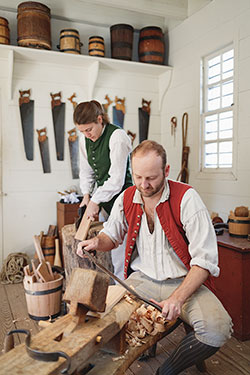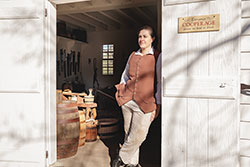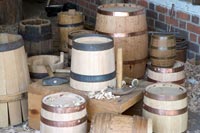Page content

Historic trades apprentice cooper Bonnie Roane and intern Harry Taylor III work in the new cooper shop in the George Wythe Lumber House,
Cooper
Ancient trade
The art of coopering dates back centuries, and the basic trade has remained unchanged. Coopering requires skill, intelligence, and strength. The tools of the trade are often handed down for generations.
Coopers crafted casks which:
- Held flour, gunpowder, tobacco, and other commodities
- Served as shipping containers
- Stored liquids from wine to milk
Many colonial coopers worked on plantations to produce the many hogsheads needed to ship tobacco from Virginia to Great Britain. Other coopers worked in towns like Williamsburg, turning staves and hoops into everything from butter churns to tubs. Large plantations often trained slaves in the trade. Coopers could also be found on military and merchant vessels, since casks were common aboard ships.
Finest casks held liquid
Today, coopers are often called "barrel makers," but a barrel is only one kind of cask, one made by what was known as a "tight cooper." Other casks included the firkin, kilderkin, hogshead, butt, rundlet, tierce, puncheon, and pipe. The tight cooper assembled clear white oak staves split from the dense center of a tree. He fit the staves one to another, and bound them with iron to make casks for liquids of all sorts.
A "slack cooper" built containers for such commodities as flour and tobacco. "White" coopering produced pails, churns, tubs, and dippers, often made of cedar or pine.
Casks, barrels, buckets, and pails found throughout Williamsburg
The coopers in the Historic Area shape their staves with broadaxes, planes, and drawknives, and then gather them in a circle secured by a ring. The gathered staves are heated over a small stove or cresset to make them pliant and the heated staves are then bent into shape. Hickory hoops hold them for banding. The trickiest step is cutting grooves inside the lips to fit the barrelheads tightly. Today, the results of the coopers' work can be seen throughout the Historic Area.


